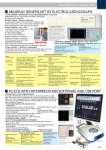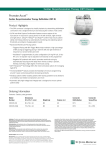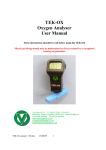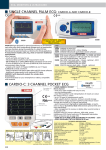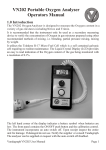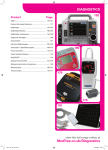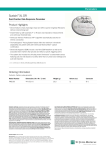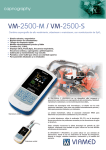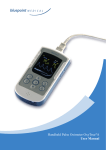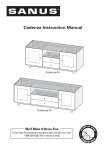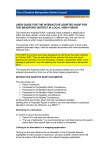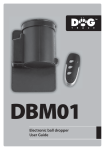Download VM-2101 User Manual
Transcript
VM-2101 Finger Oximeter User Manual Table of Contents 1. Intended Use and Warnings 1.1 Intended Use 1.2 Warnings 3 3 3 2. Operation 2.1 Battery Installation 2.2 Switching on the Device 2.3 Inserting the Finger 2.4 Commencing Monitoring 2.5 Switching off the Device 2.6 Symbols and Indicators 2.7 Alternating Between Display Modes – short button press 2.8 Adjusting Display Brightness – long button press 3 3 4 4 4 4 5 6 6 3. Error Messages – Problems – Corrective Actions 3.1 General Information 3.2 Error Messages – Causes 3.3 Problems – Causes – Corrective Actions 3.4 EMI (Electromagnetic Interference) 7 7 7 7 7 4. Maintenance – Cleaning 8 5. Symbol Definitions 8 6. Technical Specifications 8 7. Packing List 8 8. Declaration of Conformity 9 9. Contact address VM-2101 User Manual Viamed Ltd. 2008 10 3 1. Intended Use and Warnings 1.1 Intended Use The VM-2101 finger oximeter is indicated for spot monitoring of functional arterial oxygen saturation (SpO2) and pulse rate of adults and pediatrics in hospital, hospital type facilities, pre and postoperative monitoring, transport, emergency care and mobile environments, sports medicine as well as in the home care environment. 1.2 Warnings Warnings are identified by the WARNING symbol shown above. Warnings alert the user to potential serious outcomes, such as death, injury, or adverse events to the patient or user. Do not make any clinical judgments based solely on the VM-2101. The monitor is intended only as an adjunct in patient assessment. It must be used in conjunction with clinical signs and symptoms. The interpretation of the measurement values should be done only by trained health care professionals. Explosion hazard. Do not use VM-2101 in the presence of flammable anaesthetic mixture with air, oxygen, or nitrous oxide. Routinely monitor the patient to ensure that the VM-2101 is functioning and that the oximeter is correctly placed. Pulse oximetry measurements and pulse signals can be affected by certain environmental conditions, oximeter application errors, and certain patient conditions. See the appropriate sections of this manual for specific safety information. If you are uncertain about the accuracy of any measurement, check the patient’s vital signs by alternate means; then ensure that the VM-2101 is functioning correctly. The VM-2101 is not defibrillator-proof. However, it may remain attached to the patient throughout defibrillation or whilst an electrosurgical unit is in use. The measurements may be inaccurate throughout the defibrillation, or use of an electrosurgical unit, VM-2101 User Manual Viamed Ltd. 2008 and shortly thereafter. To avoid shock, the caregiver should not touch the VM-2101 while using a defibrillator on a patient. Disconnect the VM-2101 from the patient throughout magnetic resonance imaging (MRI) scanning. Induced current could potentially cause burns. Do not use a device that appears damaged. Do not use the device when optical components are exposed. 2. Operation 2.1 Battery Installation 1. Slide back the cover of the battery-compartment on the rear side of the device in the direction of the arrow. Tilt the battery-compartment cover on its hinge. 2. Insert two batteries (1.5 volt, AAA), ensuring the correct orientation in accordance with the polarity markings. 3. Tilt and slide the battery-compartment cover closed. 4 2.2 Switching on the Device Press and hold the button on the front panel briefly until the opening “welcome screen” appears. After the power-on self-test is successfully completed the device is ready for monitoring. Device ready for monitoring, no finger inserted. 2.3 Inserting the Finger Externally applied colouring agents, such as nail polish may interfere with the monitor’s ability to detect and display accurate measurements! To obtain an accurate reading it is essential that the finger oximeter is placed correctly on the patient’s finger. The light that is emitted by the finger oximeter has to transmit from the upside of the finger oximeter through the patient’s finger nail. • Turn the patient’s hand so that you can see the finger nail. • Nip one end of the finger oximeter to open • Insert the patient’s finger, nail facing the top of the finger oximeter, so that the finger is placed fully on the silicone pad. • Release the nipped end of the finger oximeter to secure it on to the patient’s finger. VM-2101 User Manual Viamed Ltd. 2008 2.4 Commencing Monitoring Once the finger oximeter is switched on and the patient’s finger is inserted correctly, monitoring will begin automatically. Monitoring in progress. 2.5 Switching off the Device The VM-2101 will automatically power off after 15 seconds when the patient’s finger is removed. 5 2.6 Symbols and Indicators 1 4 2 3 6 5 No. Symbol/Indicator Definition 1 Battery level indicator. The three segments represent the battery charge level. The symbol flashes red when the battery capacity is low. 2 The SpO2 value shows the blood oxygen saturation level expressed as a percentage. 3 Bar graph for pulse amplitude. Indicates the dynamic pulse amplitude and rate. As the detected pulse becomes stronger, more bars light with each pulse. The reverse is true for weak pulses. The colour of the bar graph is an indicator for signal quality: Green: good signal quality, very accurate measurement. Yellow: average signal quality, measurement may be inaccurate. Red: poor signal quality, unreliable measurement. 4 Pulse rate in beats per minute. 5 The reading is automatically adjusted to the pulse strength; therefore, a waveform with strong amplitude should be visible at all times. Pleth waveform 6 VM-2101 User Manual Multifunctional button - switch device on (short press) - change/rotate display (short press, when the device is switched on) - Adjustable brightness (press for more than one second, when the device is switched on) Viamed Ltd. 2008 6 2.7 Alternating Between Display Modes – short button press Depending on the personal preferences and application it is possible to alternate between a display with plethysmographic waveform and a display which shows the readings in a larger font size but without the waveform. Additionally it is possible to rotate the screen orientation. When the VM-2101 is in operating mode, each short press of the button will change the display mode. Examples of different display modes Horizontally orientated screen with plethysmographic waveform. Horizontally orientated screen with large digits but without plethysmographic waveform. 2.8 Adjusting Display Brightness – long button press Attention! Using high display brightness will consume more battery power than medium or low brightness levels and a more frequent change of batteries may be required! The finger oximeter has 6 levels of adjustable brightness. If, whilst in operation, the button is kept pressed for longer than one second, the brightness adjustment becomes active and the brightness adjustment screen is shown. For every second that the button is kept pressed, the brightness increases by one level. Once the highest level is reached the brightness will decrease by one level for every second that the button is kept pressed. When the lowest brightness level is reached the brightness will increase again. Button pressed toggles the brightness level Brightness adjustment: lowest level selected. Brightness adjustment: highest level selected. Release the button when the desired brightness level has been reached. Vertically orientated display. After a few seconds the device returns automatically into measurement mode. The device will always start with the last selected brightness level. VM-2101 User Manual Viamed Ltd. 2008 7 3. Error Messages – Problems – Corrective Actions Interference due to patient activity may be preventing the monitor from tracking the pulse. 3.1 General Information Keep the patient still, if possible. Change the application site. Physiological conditions, medical procedures, or external agents that may interfere with the finger oximeter’s ability to detect and display accurate measurements include: • Incorrect application of the finger oximeter • Placement of the finger oximeter on an extremity with a blood pressure cuff, arterial catheter, or intravascular line • Excessive patient activity • Intravascular dyes • Externally applied colouring agents, such as nail polish • Failure to shield the application site with opaque material in high ambient light conditions • Venous pulsation • Dysfunctional haemoglobin • Low perfusion 3.2 Error Messages – Causes Display shows “-- --” The finger has been removed from the finger oximeter. Check that the finger is correctly inserted into the finger oximeter. “Low battery!”, battery symbol blinking red The battery is almost completely discharged. Replace batteries immediately. 3.3 Problems – Causes – Corrective Actions Problem: There is no response to the power button. Cause/Corrective Action: Ensure that the power button is fully depressed. The batteries may be missing, discharged, or oriented incorrectly. Install new batteries. Problem: No pulse signal found Cause/Corrective Action: Check the patient. Check that the finger oximeter is placed correctly. Test the monitor on another subject. Perfusion may be too low for the monitor to track the pulse. Check the patient. Test the monitor on yourself. Change the application site. VM-2101 User Manual Viamed Ltd. 2008 There may be interference due to ambient light, or the finger oximeter may be on an extremity with a blood pressure cuff, arterial catheter, or intravascular line. Reposition the finger oximeter, as necessary. Electromagnetic interference may be preventing the monitor from tracking the pulse. Remove the source of interference. 3.4 EMI (Electromagnetic Interference) Caution: This device has been tested and found to comply with the limits for medical devices according to EN 60601-1-2, (second edition), and the Medical Device Directive 93/42/EEC. These limits are designed to provide reasonable protection against harmful interference in a typical medical installation. Due to the proliferation of radio-frequency transmitting equipment and other sources of electrical noise in healthcare environments, it is possible that high levels of such interference due to close proximity, or strength of a source, may result in disruption of performance of this device. Examples of noise sources in healthcare environments that could cause electromagnetic interference include: • • • • • Electrosurgical units Cellular phones Mobile two-way radios Electrical appliances High-definition televisions (HDTVs) The pulse can be obscured by electromagnetic interference. During such interference, measurements may seem inappropriate or the finger oximeter may not seem to operate correctly. Disruption may be evidenced by erratic readings, cessation of operation, or other incorrect functioning. If this occurs, the operating environment should be surveyed to determine the source of disruption, and the following actions taken to eliminate the source: 8 • Turn equipment in the vicinity off and on to isolate the offending equipment. • Reposition or relocate the interfering equipment. • Increase the distance between the interfering equipment and the finger oximeter. 4. Maintenance – Cleaning Maintenance There are no user-serviceable parts inside the VM-2101. The housing should not be opened. The finger oximeter requires no calibration. If service is necessary, contact qualified service personnel or your local sales representative. Caution Do not spray, pour, or spill any liquid on the VM-2101 as this may damage the finger oximeter. Surface-clean Use a soft cloth dampened with either a commercial, nonabrasive cleaner, or a solution of 70% alcohol in water. Lightly wipe the surface of the finger oximeter. Disinfection Use a soft cloth saturated with a solution of 10% chlorine bleach in tap water. Lightly wipe the surface of the finger oximeter. 5. Symbol Definitions Attention! See instructions for use! Manufacturer Date of manufacture 6. Technical Specifications Measurement Range: SpO2: 0 to 100% Pulse Rate: 20 to 300 beats per minute (bpm) Accuracy: SpO2: +/- 2% (70 to 100%) Pulse Rate: +/- 1 digit ( ≤ 100 bpm); +/- 1% ( > 100 bpm) Display : • OLED colour graphic display, 262,000 colours, 128 x 96 pixels • Data displayed: oxygen saturation, pulse rate, plethysmogram, bar graph • Indicators: signal quality, pulse amplitude, battery status Environmental Conditions: • Operating conditions: -20 to 50°C; 15 to 95% RH; 600 to 1300 hPa • Storage conditions: -30 to 70°C; 10 to 95% RH; 600 to 1500 hPa Other: • Class IIa product • Water-resistant construction IPX2 • Type BF • Dimensions (L x W x H): 57 x 33 x 27 mm • Weight (including batteries): approx. 50 g • Power Supply: 2 batteries (1.5 volt, AAA) • Battery Life: approx. 24h of continuous operation Order Number: 0012101 Applied Standards: EN 60601-1-2, BS EN ISO 9919:2005 Type BF S/N Serial number P/N Part number Observe applicable waste disposal regulations European Union approval VM-2101 User Manual Viamed Ltd. 2008 7. Packing List • • • • VM-2101, main unit Lanyard 2 x AAA batteries, 1.5 volt User manual on CD 9 8. Declaration of Conformity VM-2101 User Manual Viamed Ltd. 2008 Viamed Ltd. 15 Station Road Cross Hills Keighley West Yorkshire BD20 7DT United Kingdom Tel: +44 (0)1535 634542 Fax: +44 (0)1535 635582 E-mail: [email protected] VM-2101 – User Manual, Version: EN 1.1 08/2008 www.viamed-online.com











